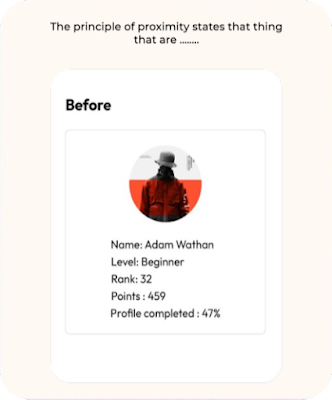👉 User Interface (UI) & User Experience (UX) - The Dynamic Duo! 👈
✨ Continuing the Series of Good Interface vs Bad Interface - Part 1
🔍 Good Interface vs. Bad Interface: Highlighting UI/UX's Importance 🎯
In today's digital landscape, where apps and websites abound, the difference between a seamless, enjoyable experience and a frustrating one often boils down to one thing: UI and UX design.
👉 UI: The Appearance-Inducing Facade 🎨
A captivating UI is akin to love at first sight! It draws users in with its design and layout. At its core, a compelling UI offers simple navigation, clear iconography, and striking visuals. However, its impact goes beyond aesthetics. An effective UI aligns with brand identity, uses consistent typography and color schemes, and ensures responsiveness across devices, enhancing usability and accessibility.
👉 UX: The Invisible Helper 🛠️
Behind every stunning UI lies the meticulous work of a UX designer. They craft a user-centric journey from wireframing to prototyping, ensuring users achieve their goals effortlessly. Seamless processes, intuitive calls to action, and thoughtful interactions are paramount. UX designers conduct extensive user research, employing techniques like user personas and usability testing to refine interfaces and anticipate user needs.
🚀 The UI/UX Synergy: Elevating Digital Experiences 🌟
True magic happens when UI and UX work harmoniously. Brands that prioritize both see improvements in customer loyalty, reduced bounce rates, and heightened user satisfaction. A superior digital experience translates into increased conversions and enhanced brand reputation. For instance:
Good Interface Example: Spotify
Bad Interface Example: Government Websites
Some government websites are notorious for their outdated interfaces and complex navigation. Users often struggle to find information, complete forms, or access services due to confusing layouts and unclear instructions. This leads to frustration and inefficiency in accessing vital resources.
👀 Curating Excellent UI/UX Case Studies 👇
Let's delve into examples that illustrate the stark contrast between good and bad interfaces:
Good Interface Example: Airbnb
- Airbnb's user-friendly interface allows travelers to effortlessly search for accommodations, filter results based on preferences, and book with confidence. The interface is visually appealing, with high-quality images and detailed descriptions that ensure transparency and trust.
- Some banking apps struggle with cluttered layouts, confusing navigation, and inconsistent design elements. This can frustrate users trying to manage finances efficiently, leading to increased bounce rates and customer dissatisfaction.
🎯 Let's Champion Excellence in UI/UX 💪
As designers, developers, and digital enthusiasts, understanding the power of UI/UX is crucial. Let's collaborate to create products that users love and businesses that excel in the digital realm. Together, we can elevate standards, foster innovation, and ensure every digital interaction leaves a positive impression.
For minimal representation space the section instead of introducing a new element as a line to creates a division.
Additional Topics to Explore:
Responsive Design: Ensuring Consistency Across Devices
Responsive design is crucial in today's multi-device environment. UI/UX designers prioritize creating interfaces that adapt seamlessly to various screen sizes and resolutions. By maintaining consistency in layout, navigation, and content presentation, they ensure a positive user experience across desktops, tablets, and smartphones.
Accessibility: Designing for All Users
Accessibility in UI/UX design focuses on making digital experiences inclusive for users with disabilities. Designers implement practices such as accessible color schemes, screen reader compatibility, and keyboard navigation. By prioritizing accessibility, they enhance usability and ensure that all users can navigate and interact effectively with digital interfaces.
Microinteractions: Enhancing Engagement Through Details
Microinteractions are subtle design elements that provide feedback, guidance, or delight to users during interactions. Examples include animated button states, progress indicators, and notification sounds. These small details contribute significantly to user engagement and satisfaction, making interactions more intuitive and enjoyable.
User Research and Testing: Iterating Based on User Feedback
UI/UX designers conduct extensive user research and usability testing to gather insights and validate design decisions. Techniques such as user interviews, surveys, and A/B testing help identify user preferences, pain points, and behavior patterns. By iterating designs based on real user feedback, designers create interfaces that meet user needs and expectations effectively.
Design Systems: Ensuring Consistency and Scalability
Design systems are comprehensive libraries of reusable components, patterns, and guidelines that ensure consistency across digital products. UI/UX designers use design systems to streamline the design process, maintain visual and functional coherence, and facilitate collaboration between design and development teams. Design systems improve efficiency and scalability while enhancing the overall user experience.
Mobile-first Design: Prioritizing Mobile UX
Mobile-first design emphasizes designing for mobile devices before scaling up to larger screens. UI/UX designers prioritize mobile UX considerations such as touch-friendly navigation, content prioritization, and performance optimization. By starting with mobile, designers create interfaces that are intuitive, efficient, and tailored to the needs of mobile users.
Emotional Design: Creating Memorable User Experiences
Emotional design focuses on evoking positive emotions and forging meaningful connections with users through visual aesthetics, storytelling, and brand personality. UI/UX designers leverage emotional design principles to create interfaces that resonate with users on a deeper level, enhancing engagement, loyalty, and brand affinity.
UI/UX Trends: Evolving Design Practices
UI/UX trends shape the future of digital experiences. Current trends include dark mode, minimalist interfaces, voice UI, augmented reality, and immersive experiences. UI/UX designers stay informed about emerging trends to innovate and adapt their design strategies, meeting evolving user expectations and technological advancements.
UX Writing: Crafting Clear and Engaging Microcopy
UX writing focuses on creating clear, concise, and user-friendly text within digital interfaces. UI/UX designers use well-crafted microcopy for labels, buttons, error messages, and instructional text to guide users effectively. By optimizing UX writing, designers enhance usability, reduce user confusion, and improve overall interaction quality.
Future of UI/UX: Anticipating Technological Advancements
The future of UI/UX design is shaped by advancements in AI, machine learning, wearable technology, and IoT. UI/UX designers anticipate how these technologies will influence user interactions, personalization, and accessibility in digital experiences. By embracing innovation, designers prepare to create more intuitive, adaptive, and immersive interfaces in the future.
✅ Also Read :- Good Interface vs Bad Interface - Part 1







Nice Articles....
ReplyDeletePost a Comment